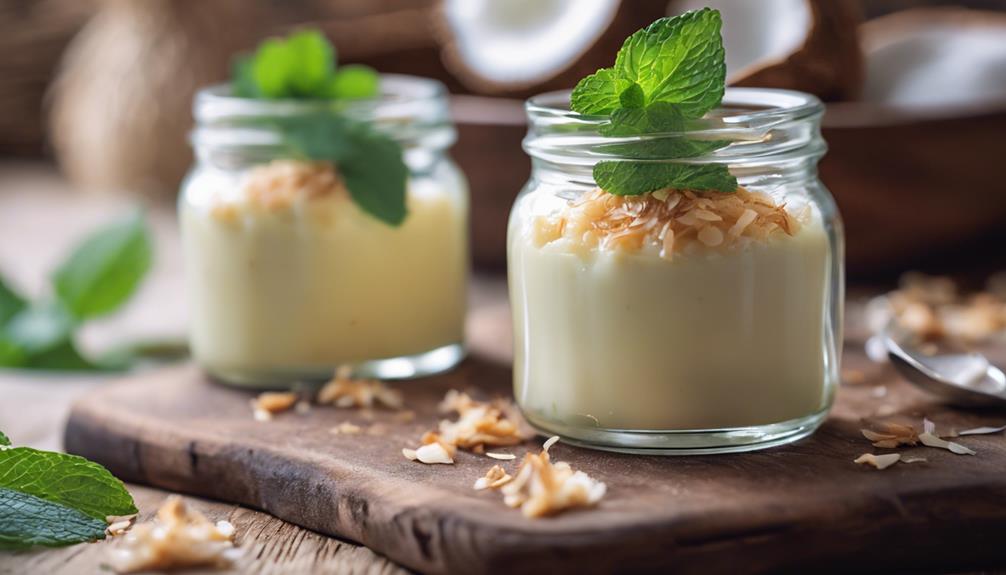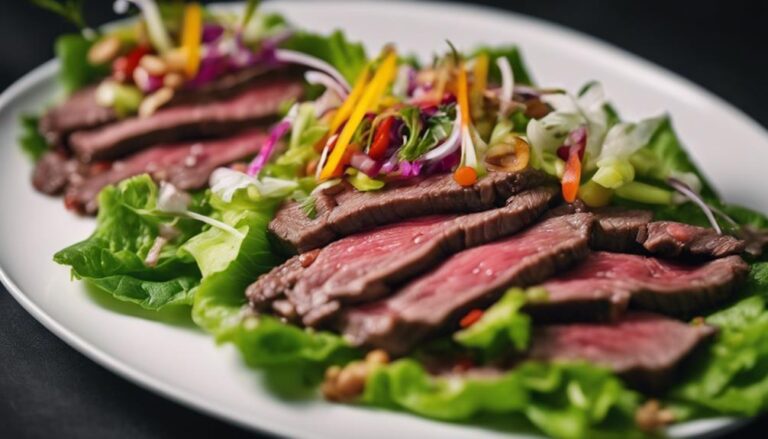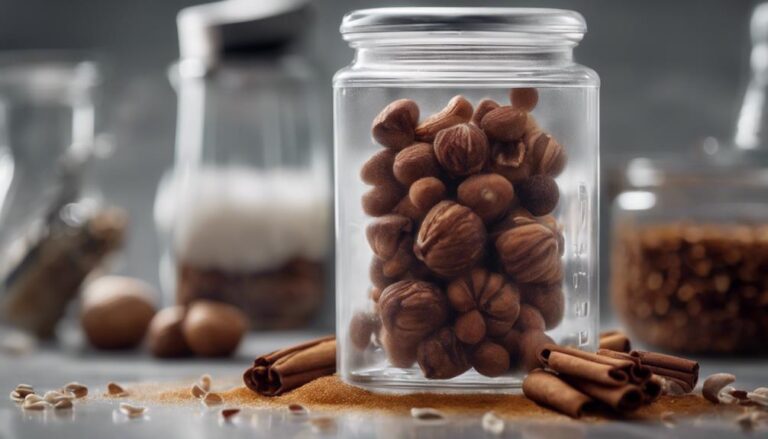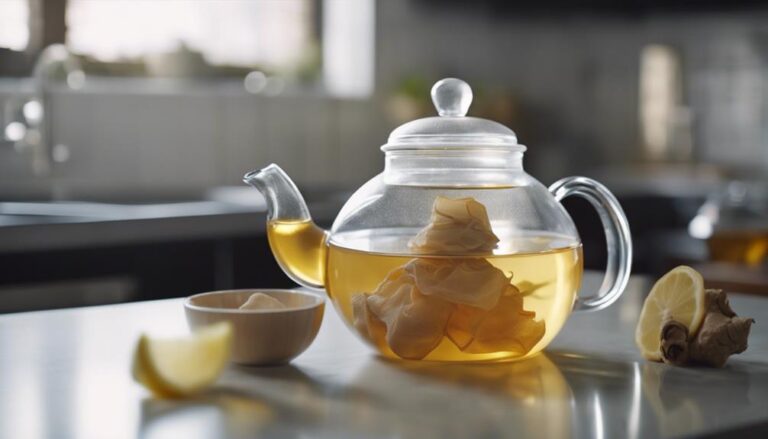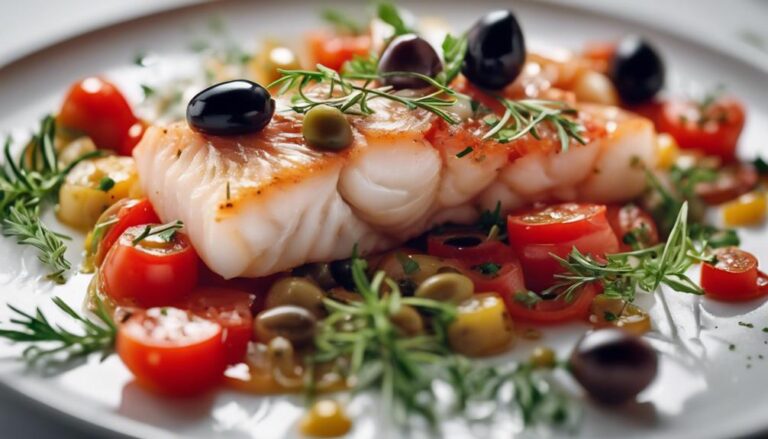Sous Vide Coconut Custard
Experience the luxurious blend of velvety coconut and precise sous vide technique with coconut custard. Achieve consistent, creamy perfection by using sous vide technology for even cooking, exceptional flavors, and a silky finish. Elevate your dessert game with this exotic treat crafted to tantalize your taste buds. Uncover the secrets to mastering this delectable sweet with ease and finesse.
What You Will Learn Here
- Sous vide cooking ensures precise temperature control for perfect coconut custard consistency.
- Use of canning jars for individual servings enhances presentation.
- Coconut custard benefits from sous vide technology for silky smooth texture.
- Chill custards for at least 4 hours to meld flavors for a satisfying dessert.
- Garnish with coconut flakes and black sesame seeds for visual appeal.
Culinary Origins and Evolution
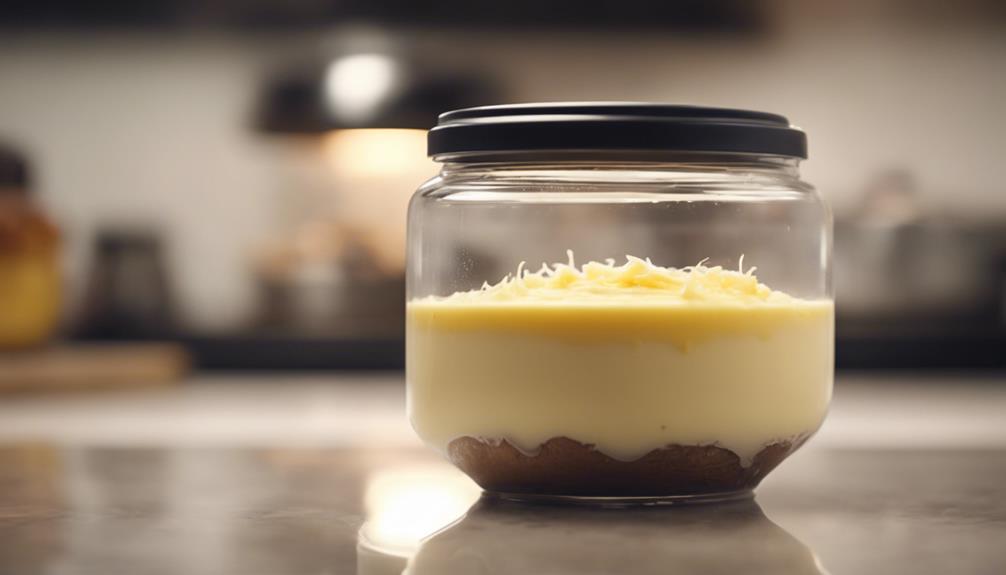
Sous Vide Coconut Custard's historical roots can be traced back to the development of modern cooking techniques that prioritize precise temperature control.
The evolution of this dessert has seen a range of flavor enhancements and innovative presentations, reflecting influences from various culinary traditions.
Historical Culinary Roots
With roots deeply embedded in Southeast Asian, South American, and Caribbean culinary traditions, coconut custard has evolved over centuries, incorporating varied ingredients and techniques to create a diverse range of interpretations.
The historical use of coconut milk in custards dates back centuries, reflecting the tropical regions where coconut trees flourish. Traditional methods often involved baking or steaming, showcasing the resourcefulness of ancient cooks.
As trade routes expanded and cultural exchanges flourished, coconut custard's popularity spread globally, leading to a fusion of culinary traditions.
The rich, creamy texture and tropical flavor of coconut custard have made it a beloved dessert in many cultures, highlighting the versatility and adaptability of coconut in creating delicious and comforting sweets with a hint of the exotic.
Modern Cooking Techniques
The evolution of modern cooking techniques in the culinary world has brought about a significant shift towards precision and consistency, particularly exemplified by the innovative method of sous vide cooking. Sous vide cooking involves vacuum-sealing food in bags and cooking it in a water bath at a controlled temperature, ensuring even cooking and retention of flavors. This technique, originating in the 1970s in France, has become popular for its precision and convenience. Chefs utilize sous vide to achieve textures and flavors difficult with traditional methods, leading to dishes like coconut custard. Below is a table highlighting the importance of sous vide in modern cooking techniques, showcasing a fusion of flavors in a dish like Matcha Coconut.
| Modern Cooking Techniques | Sous Vide Matcha Coconut |
|---|---|
| Precision and Consistency | Fusion of Matcha and Coconut flavors |
| Innovative Methods | Retention of delicate coconut and matcha notes |
| Consistent Results | Enhanced texture and flavor profile |
| Creative Culinary Practices | Experimentation with unique ingredient combinations |
| High-Quality Dishes | Exquisite Sous Vide Coconut Custard |
Influences on Flavors
Influencing the flavors of coconut custard, culinary origins and evolution reveal a rich tapestry of Southeast Asian heritage and modern culinary trends.
Coconut milk, a staple ingredient in coconut custard, has been cherished for centuries in countries like Thailand, Indonesia, and the Philippines for its velvety texture and tropical essence.
The evolution of coconut custard showcases a blend of traditional practices and contemporary influences, resulting in a dish that harmonizes cultural authenticity with innovative flavors.
Traditional recipes often incorporate indigenous elements such as palm sugar, pandan leaves, and coconut water to enhance the complexity and richness of the custard.
Egg-free Custard Variations
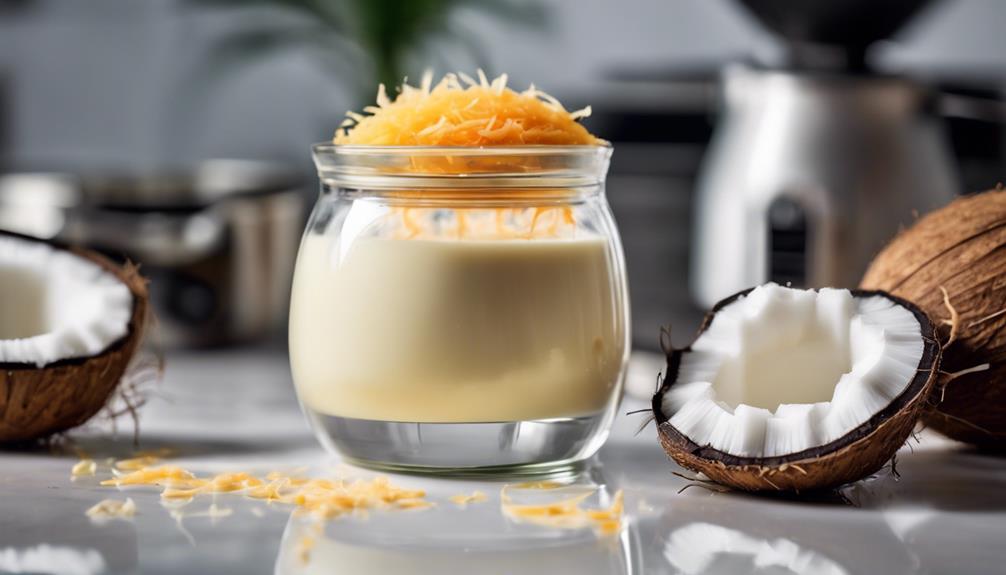
For egg-free custard variations, contemplate utilizing alternative ingredients that serve as effective substitutes for traditional eggs in custard recipes. When creating egg-free custards, you can experiment with various options to achieve a creamy and delicious dessert without using eggs.
Here are some key ingredients to contemplate:
- Silken Tofu: Provides a smooth texture and protein content similar to eggs.
- Cornstarch: Acts as a thickening agent to help custards set properly.
- Arrowroot Powder: Another thickening agent that works well in egg-free custards.
- Agar-Agar: A gelatinous substance derived from seaweed, perfect for setting custards.
These alternatives offer versatility and cater to individuals with dietary restrictions such as egg allergies or vegan preferences. By combining these ingredients with dairy-free options like coconut milk, almond milk, or soy milk, you can create a delectable egg-free custard that's both flavorful and suitable for various dietary needs.
Custard With Unique Ingredients
When considering custard recipes with unique ingredients such as matcha powder, you open up a world of innovative flavors and textures.
Matcha-infused custard recipes like Matcha Custard Souffle and Matcha Custard Ice Cream provide a delightful twist on traditional custard desserts.
The incorporation of matcha not only adds a vibrant green color but also boosts the nutritional content with its high antioxidant levels.
Matcha-infused Custard Recipe
To elevate your custard experience and introduce a unique twist, infuse your custard with matcha powder for a distinctive flavor profile and added health benefits.
- Matcha-infused custard offers a rich grassy flavor and high antioxidant content.
- The custard boasts a subtle natural sweetness complemented by a pretty sea-foam hue from the matcha.
- The cooking process involves a water bath method and tempering the egg mixture with a hot milk-cream mixture.
- Garnishing options such as coconut flakes and black sesame seeds add texture and visual appeal.
Matcha Custard Souffle
Infuse your dessert repertoire with a delightful twist by preparing a Matcha Custard Souffle, blending the unique flavors of matcha, coconut milk, eggs, sugar, and vanilla extract.
- Matcha powder offers a rich grassy flavor and vibrant green color.
- The custard boasts a creamy texture with a balance of sweet milky tea taste.
- Water bath cooking at 80 degrees Celsius for 1 hour guarantees a smooth consistency.
- Garnishing with coconut flakes and black sesame seeds adds texture and flavor.
This unique dessert not only appeals to matcha enthusiasts but also provides a visually stunning and flavorful experience. Prepare to indulge in a creamy, tea-infused treat that combines traditional custard with the exotic essence of matcha.
Matcha Custard Ice Cream
For a unique twist on traditional custard, incorporate matcha powder, coconut milk, eggs, sugar, and vanilla extract to create a flavorful Matcha Custard Ice Cream.
Matcha custard ice cream blends matcha powder, coconut milk, eggs, sugar, and vanilla extract for a distinctive flavor.
The matcha adds a rich grassy taste and antioxidants, enhancing the custard's flavor and nutritional value.
This dessert features a delicate natural sweetness and a lovely sea-foam green color from the matcha, making it visually appealing.
The creamy texture of the custard complements the sweet milky tea flavor, offering a delightful and invigorating treat.
Sous Vide Temperature Control
With sous vide technology, you can precisely set the temperature to 80°C for cooking coconut custard, ensuring precise results every time. This method offers consistent heat distribution, maintaining a constant temperature that guarantees even cooking throughout the custard.
Precise Temperature Settings
Achieving the perfect custard texture in sous vide cooking relies heavily on the precise temperature control provided, ensuring consistent and silky smooth results. When preparing your custard mixture, setting the sous vide machine to the exact temperature needed is essential to avoid overcooking or curdling. Sous vide technology allows for temperature control within 0.1°C, a level of precision that's unmatched in traditional cooking methods.
Consistent Heat Distribution
Ensuring consistent heat distribution in sous vide cooking is essential for achieving perfectly cooked custards with a velvety texture every time. Sous vide cooking maintains a specific temperature throughout the water bath, eliminating hot spots and cold spots that can lead to uneven cooking.
This precise temperature control prevents the risk of overcooking or undercooking, ensuring that custards are cooked to perfection. By cooking the custard mixture gently and evenly, sous vide allows flavors to develop harmoniously without the danger of curdling.
The stable environment provided by sous vide temperature control is ideal for custard preparation, resulting in a silky smooth texture and ideal infusion of flavors. Sous vide truly elevates custard-making to a new level of precision and consistency.
Accurate Cooking Control
To maintain precision in cooking your sous vide coconut custard, focus on the accurate control of temperature using sous vide technology. Sous vide cooking offers the advantage of precise temperature control down to 1°F or 0.5°C, ensuring your creamy custard turns out consistently perfect every time.
By keeping a constant temperature throughout the cooking process, the risk of overheating or undercooking the custard is eliminated. Setting the water bath temperature precisely with sous vide allows you to achieve the exact texture and doneness you desire in your custard.
This essential cooking control is vital in preventing curdling or scrambling of the custard mixture, resulting in a silky smooth and creamy consistency that will delight your taste buds.
Final Thoughts
In considering the overall experience of preparing and enjoying this Sous Vide Coconut Custard, it becomes evident that attention to detail in each step results in a truly delightful dessert.
The use of canning jars for individual servings not only adds a charming touch but also allows for easy customization of garnishes and portion sizes, enhancing the overall presentation.
The precise temperature control of the sous vide method guarantees a perfect custard consistency that's both creamy and rich in flavor, with the natural sweetness of coconut shining through.
Garnishing with coconut flakes and black sesame seeds not only adds visual appeal but also provides a contrasting texture that elevates each bite.
After the custards have been cooked and set, chilling them for at least 4 hours is essential as it allows the flavors to meld together, resulting in a satisfying and indulgent dessert experience.
Embracing these steps ensures a dessert that isn't only delicious but also a feast for the eyes, making it a perfect ending to any meal.
Frequently Asked Questions
Can I Use Regular Custard Recipes for Sous Vide Cooking?
Yes, you can adapt regular custard recipes for sous vide cooking. By using precise temperature control, sous vide guarantees custard consistency without curdling or overcooking. This method allows for a silky, smooth texture in your custards.
Is It Possible to Make Savory Custard Using Coconut?
Yes, you can create savory custard using coconut variations. Coconut adds a unique flavor profile to traditional custard recipes. Experiment with incorporating ingredients like lemongrass, ginger, or curry to enhance the savory notes in your custard.
How Do I Prevent Jars From Floating During Sous Vide?
To prevent jars from floating during sous vide, use jar weights. These specialized weights keep jars submerged in the water bath, ensuring even cooking. Simply place the weights on top of the jars before sealing them for a successful cooking process.
Can I Add Alcohol to Coconut Custard for Flavor?
To enhance the flavor of coconut custard, you can infuse it with alcohol. Experiment with small amounts to avoid overpowering the delicate coconut taste. Consider using rum, bourbon, or liqueurs like amaretto for a delightful twist.
Can I Use Canned Coconut Milk for This Recipe?
Yes, you can use canned coconut milk for Coconut variations. Make sure it's unsweetened and full-fat for best results. Shake the can before opening to mix the cream and liquid. Adjust consistency if needed.
Conclusion
To sum up, sous vide coconut custard is a versatile and innovative dessert that showcases the evolution of culinary techniques. With the ability to create egg-free variations and incorporate unique ingredients, this custard offers a modern twist on a classic dish.
The precise temperature control of sous vide cooking guarantees a perfect consistency every time. Experiment with different flavors and textures to create a truly memorable dessert experience.
